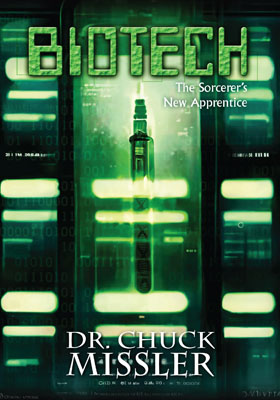The avalanche of advances in the current biotech revolution is both exciting and frightening. For instance, the promise of new remedies and cures in many diverse fields of medicine has given new hope to many sufferers but is also increasingly being accompanied with forebodings for some observers.
Consider the fields of genetics, nanotechnology, and robotics. Genetic research has been making grand strides as DNA is becoming better understood, and the human genome is beginning to yield to several mapping efforts. Nanotechnology is the science of building tiny devices out of individual atoms or molecules; it was first theorized by Nobel Prize winner Richard Feynman in 1959. Here, too, technologists are beginning to make some impressive progress.
Robotics has already delivered programmable devices that can, in some contexts, outperform humans. By combining robotics with the advances in nanotechnology, one of the goals is to develop molecule-sized machines that are injectable, programmable, and can navigate the human bloodstream. Now, developers hope to create a sentient machine.
The Latest Pandora’s Box?

In Greek mythology, Pandora was a creation of Zeus. She was created to be curious. Zeus gave Pandora a box (in ancient Greece this was called a jar) but warned her never to open it. Pandora, because of her curious nature, couldn’t stay away from the box and the urge to open it overcame her. Once opened, horrible things flew out of the box including greed, envy, hatred, pain, disease, hunger, poverty, war, and death. Thereby, all of life’s miseries had been let out into the world.
I believe we now live in a time when fiction has become fact. In these rapidly-developing fields of science, there are few safeguards against abuse or errors. Even worse, the cross-species implications and the potential for mutations are impossible to adequately anticipate. Most of the critical research being done by small laboratories is under intense competitive pressures and with few of the regulatory or procedural protections typical of larger governmental or corporate laboratories. The potential for major catastrophes has many knowledgeable observers very concerned.
Clearly the greatest apprehensions are in the areas of genetic research, genetically manipulated foods, and cloning - especially in cross-species experiments, which are likely to lead to unknown diseases and unanticipated complications.
Bio Tech to Beasts?
Another example of fiction turning into fact comes from the 1896 H.G. Wells science-fiction novel titled “The Island of Dr. Moreau.” It tells the story of a mysterious island inhabited by unnatural creatures. These unfortunate beasts were the result of horrific scientific experimentation - they were created part animal and part human. The novel warns of the dangers of unchecked and irresponsible scientific research.
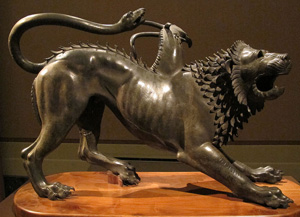
Animal-human hybrids were once purely the stuff of science fiction; however, fiction has now become reality. Scientists have created sheep that possess human hearts and livers, pigs that have been born with human blood, and a variety of other creatures whose genetic makeup has been tampered with. Biologists call these hybrid animals “chimeras.” A chimeras is an organism containing a mixture of genetically different tissues, formed by processes such as fusion of early embryos, grafting, or mutation.
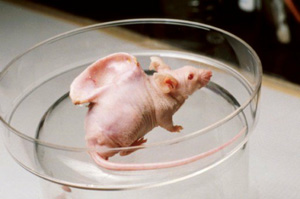 Scientists at the Salk Institute in San Diego announced in the late 20th century that they have successfully engineered mice that possess a small percentage of human brain cells.1 Scientists injected human embryonic stem cells into the brains of rodent fetuses, resulting in the birth of mice with both human and rodent brain cells. One goal of the research was to make realistic models of neurological disorders such as Parkinson’s disease and Lou Gehrig’s disease.
Scientists at the Salk Institute in San Diego announced in the late 20th century that they have successfully engineered mice that possess a small percentage of human brain cells.1 Scientists injected human embryonic stem cells into the brains of rodent fetuses, resulting in the birth of mice with both human and rodent brain cells. One goal of the research was to make realistic models of neurological disorders such as Parkinson’s disease and Lou Gehrig’s disease.
Dr. Irving Weissman (Stanford University) conducted a similar experiment, also using rodents.2 Weissman and his team injected human neural stem cells into mouse fetuses. Weissman also helped make the first mouse with a nearly complete human immune system. Although the percentage of human brain cells in the existing mice is only about one percent, Weissman said he is considering making chimeric mice whose brains are made entirely of human cells.
Scientific research involving chimeras has invoked many questions. Does the injection of human cells into a rodents brain affect its cognitive abilities? How human must a chimera become before more stringent research guidelines are applied? Are there any federal laws regulating such experiments?
Presidential Prohibition?
In the 2006 State of the Union Address, President George W. Bush stated, “Tonight I ask you to pass legislation to prohibit the most egregious abuses of medical research — human cloning in all its forms, creating or implanting embryos for experiments, creating human-animal hybrids, and buying, selling, or patenting human embryos.” Unfortunately, this cry for help was never really heeded as today we see the widespread use of DNA tampering and modification.
The frightening reality is that there are currently no federal guidelines to regulate chimeric experiments. Researchers have been left alone to regulate themselves, and there seems to be no consensus within the scientific community over what is and is not considered ethical. While politicians debate the ethical and moral issues, science has continued its advance. Moral objections to chimeric research are often dismissed by proponents as simply knee-jerk reactions based on instinctual - rather than logical - thinking. These misgivings are sometimes referred to by scientists as the “yuck factor.” Unfortunately, many researchers describe the “yuck factor” as though it were an obstacle to scientific discovery, instead of evidence of a troubled conscience.
Exploring the Human Genome
The Human Genome Project, a $3 billion international effort to map the entire genome, was launched in 1990 involving 350 labs. This was a landmark global scientific effort whose signature goal was to generate the first sequence of the human genome.
“The project was critical for advancing policies and earning increased support for the open sharing of scientific data. Concerns and questions about sequencing the human genome helped to usher in a greater emphasis on ethics in biomedical research. The project was atypical for biomedical research, in that the researchers’ work was driven by a desire to explore an unknown part of the biological world — as opposed to first formulating a theory or hypothesis.”3
“In June 2000, the International Human Genome Sequencing Consortium announced that it had produced a draft human genome sequence that accounted for 90% of the human genome. The draft sequence contained more than 150,000 areas where the DNA sequence was unknown because it could not be determined accurately (known as gaps). In April 2003, the consortium announced that it had generated an essentially complete human genome sequence, which was significantly improved from the draft sequence. Specifically, it accounted for 92% of the human genome and less than 400 gaps; it was also more accurate. On March 31, 2022, the Telomere-to-Telomere (T2T) consortium announced that it had filled in the remaining gaps and produced the first truly complete human genome sequence.”4
The Dark Side of Bio Tech Science
Clearly, there is a dark side to the emergent technologies that are bursting forth in the 21st century. As these advances combine further with developments in genetics, some are predicting the development of self-replicating machines that can lead to new, unexpected diseases. It is expected that they may ultimately have the ability to be custom-built to attack genetically distinct groups of people, or even specific individuals!
The potential military and social engineering implications are extremely disturbing. As these three areas of pursuit begin to converge, we can begin to see some terrifying possibilities that may prove far more dangerous than the weapons of mass destruction that cast their shadow over the 20th century.
The intense pursuit of these technologies, accelerated by unbridled corporate competition, is proceeding at an alarming pace. The potential for accidents or abuse is of increasing concern to those who are concerned with the stewardship of our future and that of our grandchildren.
Terrifying Tampering?
In 50 years, some predict, it will be possible to learn how and when we are likely to die and what precautions we should take to avoid death as long as possible. All the old ideas are being thrown overboard. Genetic engineering has changed the pathway of biology more than any other single scientific event in history. Now, at what seems the unending of the biological revolution, scientific journals are full of startling ideas. Genes are being used to change the taste of tomatoes and to pin down murderers and rapists.
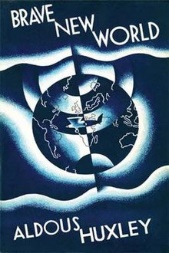 When researchers discussed the possibility of duplicating human embryos, many voiced concerns that technology had gone too far. When it finally happened–after years of ethical hand wringing and science-fiction fantasy–it was accomplished in such a low-key manner that the world nearly missed it. Given what we can clearly see now, the moral line had been crossed. A “Brave New World”5 of cookie cutter humans, baked and bred to order, seemed just around the corner.
When researchers discussed the possibility of duplicating human embryos, many voiced concerns that technology had gone too far. When it finally happened–after years of ethical hand wringing and science-fiction fantasy–it was accomplished in such a low-key manner that the world nearly missed it. Given what we can clearly see now, the moral line had been crossed. A “Brave New World”5 of cookie cutter humans, baked and bred to order, seemed just around the corner.
Discover Magazine stated, “There are Frankensteins among us, researchers who are actually figuring out how to build living things...They are not simply toying with autonomous computer programs that mimic the lives of living creatures. Instead, these latter-day creators are trying to build honest-to-god [sic] protoplasm from organic chemicals, molecule by molecule, cell by cell.”6
Your Privacy Invaded
In the escalating skirmish between privacy and genetic technology, the banking of genes is viewed as a potential Armageddon, the giant mushroom cloud looming over the horizon. The current data banking can generate “genetic fingerprinting,” an identification that has not yet reached the population at large. Many states now keep the blood of convicted felons in order to match their DNA with that found at crime scenes, and the Department of Defense is planning to take samples from active-duty personnel to be used primarily for the identification of soldiers mutilated in battle.
But the banking of genetic data, perhaps reduced to bar codes and easily shared among networked computers, will almost assuredly touch everyone. It can readily be acknowledged that a “Mark of The Beast” technology is available for implementation.
With all the prospects of genetic tinkering, here are a few questions to ponder:
- Would you want your employer or insurance company to know the genes you are carrying? Could a future of increased genetic knowledge mean employers and insurance companies will require you to present your genetic profile along with your application form?
- Should companies be allowed to own parts of our genetic code? The advance of genetic engineering raises many issues in the area of intellectual property rights–would you want someone to own the patent for your genetic information?
- Should genetic science be used to breed “perfect” human fetuses? The eugenics movement, which originated in 19th century England, was aimed at improving the hereditary qualities of the population by keeping the birth rate of the unfit in check and encouraging the reproduction of the fit. Eugenics was effectively stopped by the Nazi’s grotesque abuse of this false science.
DNA – The Language of God’s Creation
The Psalmist declared, “I will praise You, for I am fearfully and wonderfully made; Marvelous are Your works, And that my soul knows very well. My frame was not hidden from You, When I was made in secret, And skillfully wrought in the lowest parts of the earth. Your eyes saw my substance, being yet unformed. And in Your book they all were written, The days fashioned for me, When as yet there were none of them.”7
Chuck Missler says in Session One of his “Bio Tech” teaching, “I want you to see this as a constellation of miracles that occur within a miniature city. You know, if we make a map of our reality, we can start with the human body, which is made up of organs, which in turn is made up of tissues, which in turn is made up of cells. The cells inside the cells are molecular robots that have an atomic structure of subatomic particles and so on, and you get smaller than subatomic particles.
“We now discover the entities there do not have locality. So that’s another whole fascinating study of quantum physics. But we’re really going to focus on the cells and the molecular robot. So, we’re going to move down below the body, the organs, the tissues, down to the cells, and take a look at what we’re encountering there. Michael Denton published a landmark book in 1966 called ‘Evolution - A Theory in Crisis.’
“This is a very interesting book in which he demonstrates that evolution is no longer a viable explanation for what we know about the universe. But one of his remarks he makes is speaking of cells. He says, although the tiniest bacterial cells are incredibly small, each is in effect a veritable micro miniaturized factory containing thousands of exquisitely designed pieces of intricate molecular machinery made up of a hundred billion atoms, far more complicated than any machine built by man and absolutely without parallel in the non-living world.”8
Each of the human body’s 75 trillion cells, except for the red blood cells, has a full complement of chromosomes in its nucleus. Each nucleus has 46 chromosomes in 23 pairs. In each chromosome is a wadded-up strand of DNA, which includes hundreds of millions of base pairs. Stretched out straight, it would measure anywhere from three to nine feet long and about 20 atoms across. The DNA code is universal, whether it be human, rat, bat, mouse, worm, fruit fly, or microbe.
Simply put, ALL codes of life came from the same “software house.”
Our Response
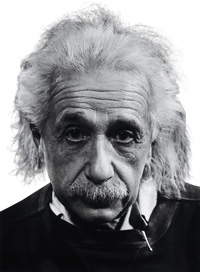 Exploring these new frontiers of science and medicine without the guidance of a strong moral compass will lead us into an ethical quagmire with dangerous repercussions. Albert Einstein once said that “science without religion is lame, religion without science is blind.” Without some kind of clear guidelines, we risk adopting a form of logic that would leave us tempted not only to ponder but also to do the unthinkable.
Exploring these new frontiers of science and medicine without the guidance of a strong moral compass will lead us into an ethical quagmire with dangerous repercussions. Albert Einstein once said that “science without religion is lame, religion without science is blind.” Without some kind of clear guidelines, we risk adopting a form of logic that would leave us tempted not only to ponder but also to do the unthinkable.
As we observe society’s steady march toward the prophetic scenario detailed in the Bible, we can’t help but ponder the strange passages, such as “Revelation Chapter 9,” which now, somehow, seem less bizarre than before.
As mankind continues to “tamper with the engines of creation,” it becomes more imperative than ever to deepen our study of God’s Word to prepare for the times ahead. He is in control, and we are indeed living in exciting times.
Postscript:
This article was taken in part from various writings by Chuck Missler.
- Jul 1994 “Tampering with the Engines of Creation”
- May 1995 “Outbreak! - Global Pestilence”
- Jun 1995 “Altering Our Genes – DNA Tapering”
- Feb 1998 “Emergent and Deliberate Diseases”
- Nov 2000 “Bacterial Communication - Microbe Warfare”
- Dec 2000 “The Biotech Revolution -
Unbridled Apprentices?” - Jan 2001 “The Sorcerer’s Apprentice - Pandora’s Box for
the 21st Century?” - Mar 2001 “Biblical Implications: Cloning”
- Sep 2001 “Stem Cell Debate Branches Out -
Unforeseen Consequences?” - Jan 2006 “Biotech or Bioterror? - Of Mice and Men”
- Feb 2006 “Another Cloning Breakthrough - The World’s
First Phony Stem Cells”
Further investigation and discovery will refine or refute the implications suggested by this article.
Notes:
1 https://www.popularmechanics.com/science/animals/a19881094/scientists-implanted-tiny-human-brains-into-mice/
5 “Brave New World” is a dystopian novel by English author Aldous Huxley, published in 1932. Largely set in a futuristic World State, whose citizens are environmentally engineered into an intelligence-based social hierarchy, the novel anticipates huge scientific advancements in reproductive technology.
7 Psalm 139:14-16
8 BIOTECH: The Sorcerer’s New Apprentice by Chuck Missler, published by Koinonia House Inc.





